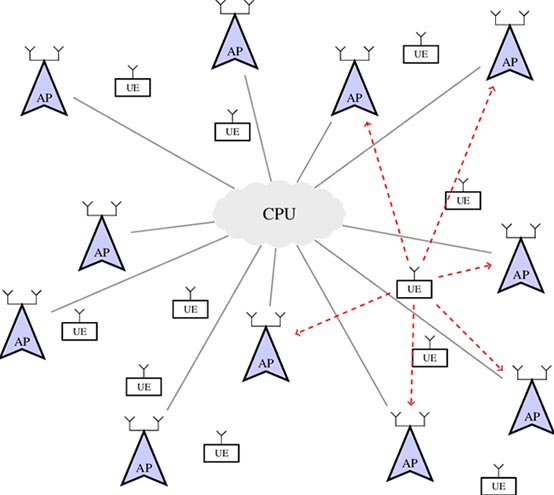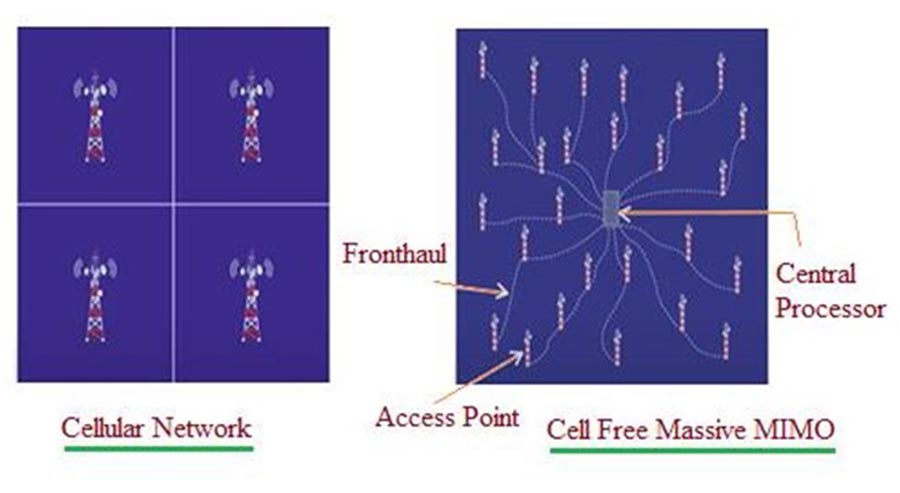Cellular structures are the foundation of conventional mobile networks, which are also called “cellular wireless networks” in everyday speech. Cellular patterns involve breaking up a certain amount of land into separate cells. Each cell phone has its own base station that it uses to connect to the network. A question that makes you think is: Should the next generation of mobile networks continue to use cellular structures? As a quick answer, I must say that the idea of cell-free networks should be accepted as the future way of doing things. In the coming age of wireless networks, it will be very hard to make sure that a huge number of devices, in the billions, can all connect to the internet at the same time. Each of these devices, in turn, needs a large throughput to support a wide range of applications, such as voice conversation, real-time video streaming, and watching high-quality cinematic experiences. Cellular networks have problems because they can’t handle a lot of connections well. User terminals on the edges of cell service experience a lot of interference, which makes their performance less than ideal. Also, it’s important to note that most traditional cellular systems are designed to meet the wants of human users. Machine-to-machine interactions, which include the Internet of Things, the Internet of Everything, Smart X, and other similar areas, are expected to play a big and important role in future wireless networks. The main problem with machine-to-machine communications is that it’s hard to set up a scalable and efficient system that lets a huge number of devices, in the billions, connect to each other without any problems. In these situations, centralized technologies that use cellular topologies don’t seem to work as well as they could because each cell can only hold a certain number of user terminals due to its own limits. What if we thought about using cell-free architecture along with technology that is not centralized? Massive MIMO technology is, in fact, a must-have if you want to support a lot of user screens and make signal processing more efficient in a distributed way. Cell-Free Massive MIMO is a new paradigm that comes about when cell-free design and the new massive MIMO technology come together.

WHAT IS THE CONCEPT OF ‘CELL FREE MASSIVE MIMO ALL ABOUT’?
The concept of Cell-Free Massive MIMO is undeniably fascinating and intellectually stimulating. Essentially, the concept entails the presence of numerous access points strategically distributed across a vast expanse. These access points operate in unison to cater to multiple user terminals concurrently and within the confines of a shared frequency spectrum. It is quite remarkable! Indeed, Cell-Free Massive MIMO revolves around the utilization of cellular frequencies, does it not? Indeed, it is worth noting that millimeter wave bands possess the capacity to be effectively employed in conjunction with cellular frequency bands. It is rather fascinating to observe the harmonious collaboration exhibited by their collective efforts. Regrettably, the absence of cellular constructs or delineations is a prevailing circumstance within our current milieu. Indubitably! We employ specialised signal processing methodologies for that purpose. Indeed, the utilization of Cell-Free Massive MIMO stems from its incorporation of the esteemed Massive MIMO technology, which strategically capitalizes on the propitious characteristics of propagation and channel hardening. Indeed, it is worth noting that Cell-Free Massive MIMO exhibits a distinct set of characteristics when compared to its counterpart, distributed Massive MIMO. Both systems employ a multitude of service antennas in a distributed fashion to accommodate a plethora of user terminals. Nevertheless, it is imperative to acknowledge that they do not possess complete congruity. Indeed, in the context of distributed Massive MIMO, it is observed that the base station antennas are judiciously dispersed throughout the confines of each cellular unit. Furthermore, it should be noted that these antennas exclusively cater to the user terminals within the confines of the designated cell. Ah, how intriguing! In the context of Cell-Free Massive MIMO, it is indeed accurate to assert that the conventional notion of cellular structures is not present. In essence, the collective operation of the service antennas is orchestrated to facilitate the provision of service to all user terminals. Please direct your attention to the visual representation depicted in the diagram presented below. The examination pertains to the architectural disparities between Cell-Free Massive MIMO and distributed Massive MIMO.

The predominant focus of contemporary investigations pertaining to CF massive MIMO systems revolves around the utilisation of the star configuration. In a precise manner, it can be stated that every Access Point (AP) is intricately connected via direct wiring to the Central Processing Unit (CPU). This configuration offers the notable benefit of simplified maintenance procedures and streamlined equipment replacement processes. Nevertheless, the quantity of access point connections within the star configuration is constrained by the quantity of central processing unit interfaces. Furthermore, it can lead to substantial expenditures associated with the installation of cabling infrastructure.
The profound potential of Coordinated Multipoint (CoMP) massive Multiple-Input Multiple-Output (MIMO) technology as a pivotal facilitator for the forthcoming mobile communication system of the next generation is thoroughly deliberated. We have presented a comprehensive analysis of the mobile CF massive MIMO communication system, with a specific emphasis on four distinct deployment structures and four diverse application scenarios. The primary obstacles encountered during the practical implementation phase are subsequently deliberated upon, specifically encompassing concerns pertaining to mobility, channel calibration, and the establishment of a scalable networking infrastructure. Furthermore, the aforementioned discourse encompasses a variety of solutions, specifically channel prediction, hierarchical cancellation, rate-splitting, and dynamic clustering. Ultimately, we have elucidated a series of auspicious avenues for future investigation, namely the complete decentralization of networks, the seamless integration of sensing and communications, and the profound implications of semantic communications.
Dr. Chitra Kiran. N
Professor Department of ECE,
Alliance College of Engineering.